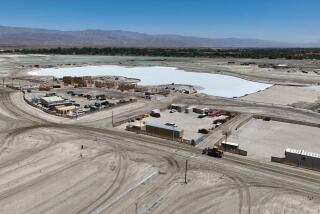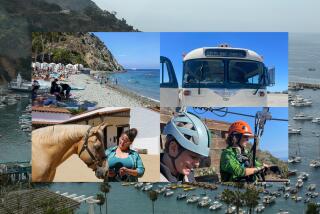Marineland Makes Way for Resort
The familiar whale spout sign is missing its whale. Behind scraggly Italian cypress, the five entrance flagpoles are barely visible.
The sweeping 170-degree ocean view from the once-gracious Catalina Room is blocked by a tangle of weeds encircling the patio where wedding couples waltzed.
And inside the big round building that was the backdrop for MTV television shows such as âBeach House,â ragged black graffiti covers the walls.
Demolition started Thursday in Rancho Palos Verdes on the last remaining buildings of what was once Marineland of the Pacific, a mecca for Los Angeles-area families for more than three decades. One year older than Disneyland, Marineland, which opened in 1954, was one of Southern Californiaâs first theme parks. It once billed itself as âthe worldâs largest oceanariumâ and featured such baby boom icons as the 320-foot-high Skytower and Bubbles, billed as the worldâs first trained and performing whale.
Now, 19 years after Marineland closed its doors, workers have begun transforming the site on a spectacular oceanfront bluff at the south face of the Palos Verdes Peninsula into the posh 102-acre Terranea resort, due to open in 2008.
Today, the vacant site is distinguished by weeds, graffiti, broken glass and discarded empty bottles of cheap wine.
It has become a popular playground for young people who cut through the wire-mesh fences and hold late-night parties, say city officials and representatives of developer Lowe Enterprises Inc.
They call the buildings a safety hazard, and say theyâre concerned about liability.
Vandals repeatedly tear down the plywood nailed over the windows of about 20 remaining buildings, mostly decrepit one-story wood structures from the 1950s, hidden behind overgrown ficus and 5-foot-high fennel.
âLiterally every week, we board these buildings up again,â said landscape architect Todd Majcher, a Lowe assistant vice president and project manager, as he pointed to a section of the wire-mesh fence that had been cut and then mended with wire.
The Skytower and aquariums were torn down long ago. Still standing are the 12-room motel, a restaurant and the Catalina Room, which thrived as a wedding and banquet venue long after the park closed. Catered by New York Food Co. of El Segundo, it shut down less than two years ago.
The Catalina Room remains virtually intact, with a wooden dance floor, a pastel mural of Catalina Island and a bar and fireplace decorated with teal and terracotta tile.
But the bar is bare, the air smells musty, and the room is now used to store boxes of literature and water bottles bearing the Terranea logo.
No one has stepped forward to protest the demolition or claim the buildings have historic significance, city officials said.
Marineland opened at the start of the baby boom era, before Disneyland and Sea World overshadowed it.
It drew schoolchildren from throughout the region, oohing and aahing at the cavorting killer whales Orky and Corky, and crowding into the Sea Arena and the Big Reef.
The entrance near the southernmost tip of Hawthorne Boulevard was marked by a tall concrete pillar with two curls -- a whaleâs spout, some say, or perhaps a stylized whaleâs tail -- with a whale and a couple of frolicking dolphins attached.
As Sea World boomed in San Diego, Marineland fell out of fashion. After it closed, the federal government deemed the Skytower an aviation problem, and it was demolished.
Marines from Camp Pendleton used the land for exercises, and it became a site for such films as âPirates of the Caribbean,â âFun with Dick & Jane,â âThe Aviator,â âPatriot Games,â âPearl Harbor,â âCharlieâs Angels,â âSpiderman,â âCon Airâ and âG.I. Jane,â along with television shows such as âLost,â âBaywatchâ and âThe O.C.â
Over the years since the closing, plans to redevelop the land emerged and fell apart. Owners also came and went.
One owner defaulted on its loans and filed for bankruptcy. Meanwhile, all plans drew close scrutiny from environmentalists, residents and Coastal Commission experts because of the bluffs and fragile vegetation.
Terranea Resort, the latest project, is the work of Loweâs destination and hotel division, which is also developing the Grizzly Ranch in Portola and the Stone Eagle Golf Club in Palm Desert. Loweâs original project drew public opposition because of its size. The City Council rejected it, but approved the current smaller plan.The resort will feature a luxury hotel, 32 villas, casitas, a spa, restaurants and a golf academy. It will have little in common with the old theme park, judging from a Terranea brochure: âThis captivating retreat gives one a sense of being enshrouded in a world of tranquillity. Set upon graceful terraces staircasing down to the Pacific, it is a classic American playground destined to rival the worldâs most legendary seaside escapes.â
Terraneaâs developers promise that they will maintain public access and will restore two acres of oceanfront land with native plants, including habitat for the rare El Segundo blue butterfly, which lives on the western edge of the site.
The demolition project will continue into August, and groundbreaking for Terranea is set for October.
Soon all of Marineland will be gone from the site, even the entrance signâs concrete pillar, which Majcher said is structurally unsound.
The concrete whale that once hung from the sign still lives on, however. It was donated to the city of Ranchos Palos Verdes and is stored in the city yard.
The whale may go on display again at the newly expanded Point Vicente Interpretive Center nearby, said city planner Ara Mihranian.
âWeâre very into preserving history.â
Times researchers Vicki Gallay and John Tyrrell contributed to this report.
More to Read
Sign up for The Wild
Weâll help you find the best places to hike, bike and run, as well as the perfect silent spots for meditation and yoga.
You may occasionally receive promotional content from the Los Angeles Times.






